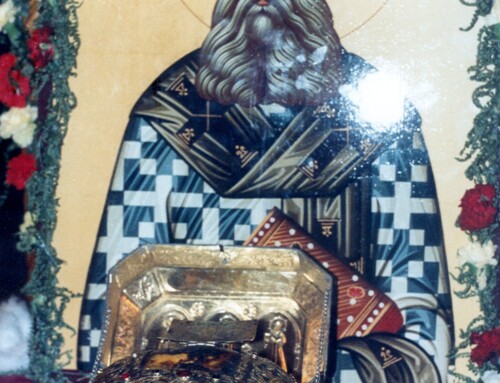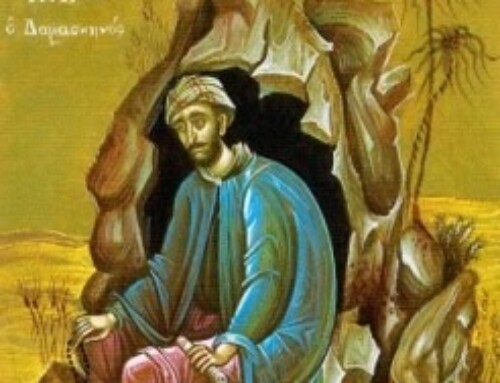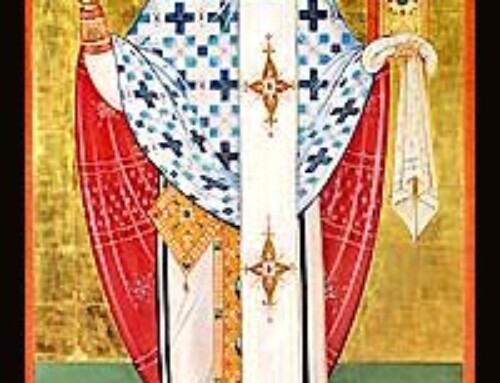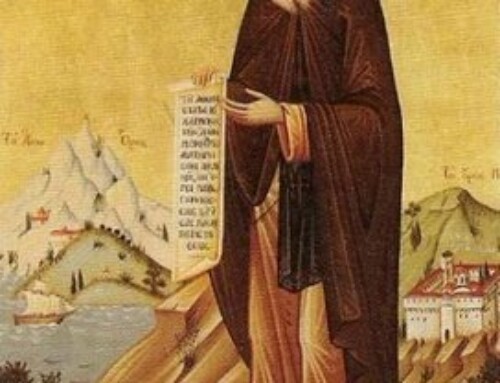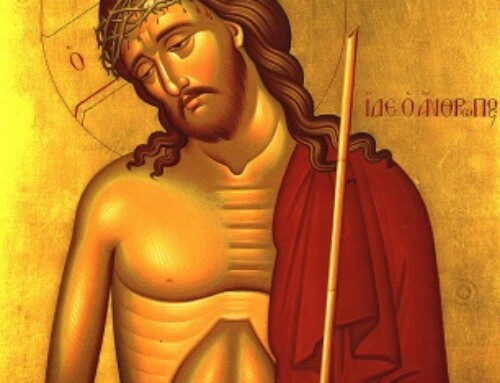Catechizin2 the Priest
Introduction: The Role Of Holy Tradition in Orthodox Religious Education
I have been asked to speak for a few moments on the subject of the continuing catechesis of the priest. My only expertise in this area is based upon over 32 years of making mistakes and having to learn things the hard way. Thomas Groome in his work “Christian Religious Education” informs us that the word catechesis comes from the Greek verb katechein which means to resound, echo, or pass down. Within the context of the Church the process of resounding or passing down began on Pentecost when Peter proclaimed the redemptive death and resurrection of Jesus Christ and announced that Jesus was both Christ and Lord. The plan of God was now made manifest in His Son Jesus Christ. The kegyma had now been proclaimed.
Our Lord was certainly the One who proclaimed the Kingdom, but He was also the teacher. He as addressed as “Teacher”. The Church has carried out both ministries of kergyma and teaching since its inception. The church has long been aware of its ministry of catechesis.
I do not claim any special expertise in the theoretical issues of cathecesis or religious education, but it does seem that as Orthodox Christians our methodology in matters of religious education is going to differ from that of other churches, especially those of the Reformation tradition.
If one holds to the Reformation position that Divine Revelation is contained completely in the written scriptures, then religious education is largely the study of the bible. It will also tend to discount or marginalize all that has happened since the close of the New Testament era. This does not mean that they would ignore doctrinal or moral questions, but the context of their teaching would be only biblical. The more one holds to the so/a Scriptura position, the less one speaks of the history of the Church. This is not just a matter of preferring one catechetical method to another. It is rooted in a very important theological position.
Orthodox religious education, like Orthodox theology must necessarily be concerned both with the self-revelation of God in the mystery of the Incarnation (or Christ event) and also with the process whereby the Holy Spirit has been leading the church in all Truth down through the centuries. Our methodology must be historical because God has acted and continues to act in human history. “it is time for the Lord to act.”
b~1,eve f~aa-t ~ ~ ~ ‘~“~ –
All these constitute what the Church calls the Holy Tradition. We believe that they have been ~Y~TI ~ us ‘oy ~he lloXy ~pirit, who, true to the promise of the Lord was to be with the church forever. As Orthodox Christians we believe that the various elements of Holy Tradition all witness to the same Truth. What is proclaimed in the Gospels is professed by the Councils and Creed, sung and prayed in the services of the Church, and depicted in the Icons.
St. Athanasius and the later Cappodocians did not teach a new revelation or a new truth when they fought for Nicea and insisted on the full divinity of both Jesus Christ and the Holy Spirit. But I believe that they were led by the Holy Spirit to a deeper understanding of these holy mysteries. The Troparion of the Feast of the Annunciation –which proclaims “today is the beginning of our salvation”—does not teach a new revelation about our salvation, but it does reaffirm that the Augustinian emphasis of salvation as a new legal status for man before God–is incomplete. This little troparion reaffirms the important of the Incarnation, that our salvation needed our reunification to God and that the mystery of our salvation began at the instant of the Incarnation in the body of the Theotokos.
Religious education in the Orthodox Church should include all the elements of Holy Tradition. And the fact that the Holy Spirit is present within the life of the Church today means that our catechesis is not simply the “history” of Holy Tradition. It is a contemplation of the Mystery of God creating, revealing, saving and sanctif~ring us. THEORJA. This process must involve not only the church— in the person of the teacher– but also the student. How many times have we met some person who says, “well, I attended such and such a church for 20 years and they never taught me about Jesus.” Right!
Continuing Education of the Priest
How do we as priests, deacons and teachers continue this process in our own lives? How do we go about the process of continuing education. No doubt there are countless ways. (The first is to attend a seminary that makes its students life long learners, My first introduction to the study of theology was in the area of scholastic theology. Later I was introduced to historical theolo2v
We believe that God’s revelation in history was His Living Word, His Divine Son. But we also believe that this revelation is witnessed and made present to us through the Holy Scripture, the writings of the Fathers of the Church, The Ecumenical Council with their creedal, canonical and dogmatic statements, The Liturgical and Sacramental life of the church with their prayers and hymns, as well as what the church calls its “theology in color”, the Holy Icons. (See Sheet No~
All these constitute what the Church calls the Holy Tradition. We believe that they have been given to us by the Holy Spirit, who, true to the promise of the Lord was to be with the church forever. As Orthodox Christians we believe that the various elements of Holy Tradition all witness to the same Truth. What is proclaimed in the Gospels is professed by the Councils and Creed, sung and prayed in the services of the Church, and depicted in the Icons.
St. Athanasius and the later Cappodocians did not teach a new revelation or a new truth when they fought for Nicea and insisted on the full divinity of both Jesus Christ and the Holy Spirit. But I believe that they were led by the Holy Spirit to a deeper understanding of these holy mysteries. The Troparion of the Feast of the Annunciation –which proclaims “today is the beginning of our salvation”—does not teach a new revelation about our salvation, but it does reaffirm that the Augustinian emphasis of salvation as a new legal status for man before God–is incomplete. This little troparion reaffirms the important of the Incarnation, that our salvation needed our reunification to God and that the mystery of our salvation began at the instant of the Incarnation in the body of the Theotokos.
Religious education in the Orthodox Church should include all the elements of Holy Tradition. And the fact that the Holy Spirit is present within the life of the Church today means that our catechesis is not simply the “history” of Holy Tradition. It is a contemplation of the Mystery of God creating, revealing, saving and sanctifying us. THEORIA. This process must involve not only the church— in the person of the teacher– but also the student. How many times have we met some person who says, “well, I attended such and such a church for 20 years and they never taught me about Jesus.” Right!
Continuing Education of the Priest
How do we as priests, deacons and teachers continue this process in our own lives? How do we go about the process of continuing education. No doubt there are countless ways. (The first is to attend a seminary that makes its students life long learners, My first introduction to the study of theology was in the area of scholastic theology. Later I was introduced to historical theology that focused on what we would call the T-Iolv Tr~iifinn T t*in’t th~nL that T buxrc. c.~r~r c~”.’~
A. Example From the Fathers
I asked myself if there is a method to be found in the history of the Church. I think in one sense that there is. The fathers of the Church entered into the mystery of revelation and salvation–and reflected on those mysteries– not because they had nothing else to do. I am certainly not equating us and what we do with the Fathers, but there is a parallel here. Both we and the Fathers reflect upon the mysteries of faith. They did so because the circumstances of their lives “forced” them to do so. Ignatius was confronted by those who would divide the church.. He was also confronted by his own impending martyrdom. We are the beneficiaries of his reflection. Clement was confronted with the questions about the presbyters at Corinth; the Greek Apologists were confronted with the hostility of the empire. Irenaeus was confronted by the Gnostics. He was compelled to address the issue of methodology– of how one would go about answering such challenges–using Christian sources both scripture and tradition. Athenasius was challenged by Anus. Basil and Gregory Na.zianzus were challenged by the rejection of the Nicean theology. Would we have the theological orations of Gregory the Theologian had he not been compelled to go to Constantinople to bring the city back to the faith of Nicea and away from Anianism. The point I am making is all this is that as the challenges of the early church produced the theology of the Fathers, the challenges of our own times can draw us into the reflection upon the same mystery of revelation and salvation.
Do such challenges exist today? We are surrounded by thousands of denominations all claiming orthodoxy of belief The issues of our times can compel us to do what the Fathers did–to go back to the sources of our faith. That is certainly one approach to the problem.
B. Adult Education As A Method Of Personal Catechesis
In what other ways can we continue what was begun when we were catechized? There are a number of possibilities. One can take courses in continuing education. One can attend institutes and symposia. One can read theological books. One can meditate on the Holy Scriptures. One can pray. I am sure that everyone here has done these things and continues to do these things. But what I am going to speak about for a few moments is the method that I have come to use over the past 20 years. It was not anything that I really thought out, it just simply happened. In a certain sense you don’t have to wait for a problem to force you into this process of continued priestly education, you can begin it on your own. I think that this is what I have done.
Over the past 20 or so years, in each pastoral situation, I have tried to plan some kind of adult education for interested people. Here is the secret.., it ou want to learn about somethin . . .teach
Sometimes circumstances just seem to hand you an “assignment”. You may be asked to make a presentation on a particular topic. But you can always give yourself the assignment. You can do this by offering a series of talks on some aspect of Orthodox faith. Thisw~u1±hhe-m.~~ic
C. The Importance Of Holy Tradition
If you focus on the fundamentals of Holy Tradition, you will always be going back to the very same Holy Mystery. You don’t always have to do biblical topics or just the basics of Orthodoxy. You certainly can and should do these, but Holy Tradition offers us a way of teaching others and at the same time giving us a program of continuing education. All you need is a decent library, the willingness to do it, and the announcement in your church that you are going to do it. One likes to have a nice group of students but sometimes you only get two or three. This does not matter. What is important is if you do the study, you will be the beneficiary yourself I am going to give you a number of example of how I have done this over the years.
HOLY TRADITION
SCRIPTURE
ICON>/
CANONS
FATH ERS
CREED
7 COUNCILS
SACRAM ENTS
A Little Course In the Fathers Of The Church
How can a priest in a parish offer a course in the Fathers. The task seems overwhelming. It does not have to be, especially if you limit yourself to something reasonable. I recently did a series of about six evenings on the earliest of the Fathers. I called the series “Early Christian Writings”. This seemed a better name for the series than the Fathers. The people who came were mostly recent converts or non-Orthodox people. The format was to read the selections aloud and then address questions that I thought would be of interest, or to allow the participants to raise their own questions. One method than can be used is to ask three questions: what does the document say about Christ, what does the document say about the church, and what does the document say about ethics.
1. The Didache
A. The importance of an ethical life
B. Did the early Christians fast
C. How did the early Christians worship
D. How did the early Christians baptize
E. Did the question of abortion concern the early Christians
2. Selections from I Clement
A. The permanence of the Hierarchical ministries
3. The Letters of Jgnatius ofAntioch (2 evenings)
A. The issue of unity in the church
B. The issue of correct belief (as opposed to the Docetists)
C. The issue of the eucharist
D. The issue of the role of the bishop, presbyter and deacon
4. The Martyrdom of Polycarp
5 Selections from Justin’s First Apology
A. His defense of the Christian faith
B His teaching about Jesus Christ
C His teaching about ethics
D. His witness to early baptism and eucharist
E. The significance of the Old Testament
6. Selections from Irenaeus Against Heresies (Book III)
A. The importance of both Scripture and Tradition
B. The issue of Apostolic Succession
Bibliography:
Early Christian Fathers, edited by Cyril C. Richardson, Collier Books, Macmillan Publishing Co., New York 1970 (can be bought used through the internet)
Pairology, by Joharmes Quasten (Four Volumes) Christian Classics Inc., Westminster MD, 1992.
CHRISTIAN WRITERS OF THE 1ST AND SECOND CENTURIES
THE TYPES OF EARLY CHRISTIAN WRiTINGS
Described by Cyril Richardson in (EARLY CHRISTIAN FATHERS (Edited by Cyril C. Richardson. Collier Books. Macmillan Publishing Co.. New York. 1970)
1. Letters The Dominant form of early Christian writings (sim. to NT)
2. Apologies Writings in defense of the faith (Quadratus, Justin)
3. Sermons II Clement (before 750 AD)
4. Briefs (a short official statement, a summary) Letter To Diognetus (750-200 AD)
5. Apocalvpses The Shepherd of Hernias (95-100 AD)
6. Church Manuals The Teaching Of The 12 Apostles
7. Theological Treatises Fragments of Papias (early 2nd cent.)
8. Expositions of the faith Against Heresies by Irenaeus of Lyons (180 AD)
9. Poetry The Odes of Solomon (c. 150 AD)
10.Non Scriptural Gospels, Letters. Acts .Apocalvpses (2nd cent)
CHARACTERISTICS OF EARLY CHRISTIAN WRITINGS
1. Literary simplicity
2. Ernest religious conviction
3. Independence of Hellenistic philosophy and rhetoric (less so the Apologists)
4. Close to the New Testament in their artlessness
5. The come from a time when the church warred against paganism and internal schism (Gnosticism and Montanism)
6. They have a strong concern for Order and Unity in the Church.
7. They are virtually all Gentile (rather than Jewish) writings
GROUPS OF EARLY CHRISTIAN WRITINGS
(Different scholars have formed different groupings of these writings)
1. THE APOSTOLIC FATHERS
A. The Letter of Barnabas (c. 130 AD)
B. The Shepherd of Hernias (An Apocalypse) (95-100 AD)
C. I Clement (A Letter) (96 AD) JI Clement (A sermon) (before 150 AD)
D. Letters of Ignatius of Antioch (c. 107 AD)
Ignatius of Antioch To The Ephesians
Ignatius of Antioch To The Magnesians
Ignatius of Antioch To The Trallians
Ignatius of Antioch To The Romans
Ignatius of Antioch To The Philadelphians
Ignatius of Antioch To The Smyrnaeans
Ignatius of Antioch To Polycarp
E. The Letter of Polycarp To The Philippians (c. 107 AD)
F. The Letter of the Church of Smyrna to the Church of Philomelium also known as The Martyrdom of Polycam (166-7 AD)
G Fragments of Papias (early 2nd cent.)
H. Fragments of Quadratus (125-129 AD)
I. The Teaching Of The Twelve Apostles, AKA The Didache (A church manual) (70 AD? 90 AD?)
V
2. THE APOLOGISTS (ALSO CALLED ‘THE GREEK APOLOGISTS”)
A. The Apology of Quadratus (125-129 AD)
B. The Apology of Aristides (138-147 AD)
C. The Letter To Diognetus (150 -200 AD)
0. Justin’s Apology (c. 150 AD)
E. Tatian the Syrian Address To The Greeks (160s AD)
F. Miltiades (late 2nd cent.)
C. Apollinarius of Hierapolis (c. 170 AD)
H. Athenagoras The Anthenian (177)
I. Theophilus of Antioch (180s AD)
J. Melito of Sardis (before 190 AD)
K. Hermias (late 2nd cent.)
3. THE A1’OCRYPHAL LITERATURE OF THE NEW TESTAMENT
A. Apocryphal Gospels (some examples…)
The Gospel According To the Egyptians
The Gospel Of The Hebrews
The Gospel of Peter
The Infancy Gospel of Thomas
The Gospel of the Ebionites
B. Apocryphal Acts of the Apostles
The Acts Of Paul
The Acts of John
The Acts of Peter
The Acts of Thomas
C. Apocryphal Apocalypses
0. Apocryphal Epistles of the Apostles
4. CHRISTIAN POETRY
A. The First Christian Hymns
B. The Odes of Solomon (c. 150 AD)
C. The Christian Sibylline Oracles (after 150 AD)
D. The Sayings of Sextus (200 AD)
E. Christian Poetry on Tombstones
5. ACTS OF THE MARTYRS
A. The Acts of St. Justin (163-7 AD)
B. The Acts of the Martyrs of Scilli ((180 AD)
C. The Acts of St. Cyprian (late 3rd cent.)
0. The Martyrdom of Polycarp (166-7 AD)
E. The Letter of the Churches of Vienne and Lyons (177-8 AD)
F. The Passion of Perpetua and Felicitas (202-3 AD)
G. The Acts of St. Carpus, Paylus. and Agathonice
6. GNOSTIC AND ANTIGNOSTIC LITERATURE
Most Gnostic literature has perished, although excerpts in the Fathers of the Church enable us to reconstruct their systems of thought. Two of the most important Gnostics are Marcion and Valentinus
7. ANTIHERETICAL LITERATURE
A. Against Heresies by St. Irenaeus of Lyon
Course Number Two: Heresies and Controversies
Heresies and Controversies in Christian History
I. New Testament Era Controversies
[Are Christians To Be Observers of Torah?]A) The Torah and members of the Church
B) Various groups of Judaizers:
II Heresies & Controversies Concerning Christ & The Trinity
[Who is God and Who Is Jesus?]A) Docetism: (From the late first centniy)
B) Gnosticism (2nd cent.) (1. The Syrian, Egyptian, Judaizing, Pontic, Type) Antinomiamsm
C) Monarchianism (2nd-3rd cent.)
1. Adoptiomsm (Ebionites) (2nd cent.)
2. Modalism (Sabellianism) Patripassionism (3rd cent.)
D) Arianism (Anus 250 – 336)
E) Attempts to overthrow the Nicene Formula
III. Heresies regarding the Church and the Sacraments
[What is the role of the Church and Sacraments in our salvation?]A) Montanism (Late Second Century)
B) Donatism (Mid 300s)
C) Priscillianism (Late 300s) (Spain)
IV. Heresies Concernina The Relationshiv of the Divinity and Humanity In Christ
[What does “Both God and Man” mean in reference to Jesus Christ?]A) Apollinarianism (Apollinarius d. c.3 90) (Monophysitism)
B) Nestorianism (Nestorius d.c.45 1)
C) Eutychianism (Eutyches d.c. 454) (Monophysitism) (The Tome Of Leo I, 449)
D) The Henotikon of Zeno 482
E) The “Three Chapters” Edict of 543
F) Monotheletism 624 Conference of Monothelites with Emp. Heraclius
V. The Issue of the Nature of Man. Freedom. Sin, and Divine Grace: Pela~ianism:
The Resi,onse of St. Augustine
[What part do we play in our eternal salvation?]VI. Iconoclasm (725 – 842)
[What was so important about Christian art that people died for it?]VII. The Schisms: The Photian Schism and the Schism of 1054
[What caused the Church of Rome and those of the East to separate?]A) Nicholas I and the Photian Schism
B) THE SCHISM OF 1054
C) Efforts at reunion: The Council of Florence 1438
VIII Western Controversies
[How is Christ present in the Eucharist? What role does the civil authority have in the Church?What is the highest teaching and governing authority in the Church?]
A) The Eucharistic Heresies (Berenagarius of Tours d.c. 1088)
B) The Investiture Controversy (lay control of church offices – late 11th & 12)
C) Conciliarism in the Western Church
X. Hesvchasm: St. Gre~orv Palamas (14th Century)
[Can man truly enter into union with God? If so, how?]IX Dualistic Contoversies
[Did Jesus come only to save “souls”? How important is material world?]A) The Bogomils B.) The Cathari
XI. The Reformation (1517ff)
[What caused the break up of the Western Church?] [Why did the Reformation churches come into existence?] A) The Lutheran ReformationB) The Anglican Reformation
C) The Radical Reformation and Calvinism (Presbyterians, AnnBaptists)
TRINITARIAN AND CHRISTOLOGICAL CONTROVERSIES AND HERESIES
EBIONITES:
Late 2nd cent. First to espouse “Adoptionism” (Christ is the “adopted” Son of God
ARIANISM
ARIUS (c.250-336)
denied the
DIVINE NATURE
MONOTHELETISM
(Condemned in 680)
Denied that Christ
had both a human and
Divine Will
MODALISM
One God comes in
the mode of Father
Son or H.S.
THE TRINITY ONE GOD IN
SON – WORD or LOGOS
MACEDONIUS
HOLY SPIRIT (d.c.362) denied
the DIVINITY OF
THE HOLY SPIRIT
NESTORIUS (d.c.451) denie the ONE PERSON
ONE PERSON
DIVINE HUMAN
NATURE NATURE
JE US CH ST
/
MONOPHYSITISM
EUTYCHES (c.378-
454) denied the two
Natures in Jesus
Christ
HERESIES
DOCETISM (dokein) “to seem or appear”. Taught that Jesus only appeared to be human
APOWNARIUS
(0.310-390) denIed
the HUMAN
NATURE
GNOSTICISM
Rejection of the God of the Old Testament Christ was an emissary of the “Supreme God”, bringing gnosis. He temporarily inhabited a human body. (Valentin us, Basilides, Marcion) Gnosticism is more than a “Christian Heresy’. A broad religious movement which came into prominence in the 2nd century.
DOCETISM: Taught that Jesus only “seemed” to be human.
MODALISM: (SabelIIanIsm): Denied the permanence of the Three Persons
(“The Father descended to the Virgin”; (Patripasslonlsm) ( Monarchlanlsm)
God comes in the “mode” of the Father, then the Son, then the Holy Spirit. Early
3rd century Sabellians were Noetus and Praxeas.
ARIANISM: THE DENIAL OF THE FULL DIVINTY OF CHRIST (AND THEREBY THE TRINITY)
MACEDO NI A NI SM (Pneumatomachi) DENIAL OF THE DIVINITY OF THE HOLY SPIRIT
ADOPTION ISM CHRIST IS SEEN AS THE “ADOPTED” NOT TRUE SON OF GOD
APOLLI NARI ANISM: DENIAL OF THE FULL HUMANITY OF CHRIST
N ESTORI ANI SM: DENIAL OF THE ONE PERSONHOOD OF CHRIST
EUTYCHIANISM (MONOPHYSITISM) DENIALOFTHE TWO NATURES OFCHRIST
MONOTHELETI SM: THE DENIAL OF BOTH THE HUMAN AND DIVINE WILL IN CHRIST
THE ECUMENICAL COUNCILS
COUNCIL OF NICEA: 325 ARIANISM
I COUNCIL OF CONSTANTINOPLE 381 MACEDONIANISM, APOLLINARIANISM
COUNCIL OF EPHESUS 431 NESTORIANISM
COUNCIL OF CHALCEDON 451 EUTYCHIANISM -MONOPHYSITISM
II COUNCIL OF CONSTANTINOPLE 553 THE THREE CHAPTERS
III COUNCIL OF CONSTANTINOPLE 680-1 MONOTHELITISM
II COUNCIL OF NICEA 787 ICONCLASM
THE PLACE AND MEAMNG OF THE ICON iN THE ORTHODOX CHURCH
I. Introduction and Defintion of The Icon: What do we mean by an Icon?
II. Icons as part of the Holy Tradition in Orthodoxy
III. The Thelogical foundation of the Icon God reveals His Word
God reveals His Image (Christ is the Image (icon) of the invisible God
IV. The Icon in Church History
A. PreConstantine Catacombs, tradition of early icons; witness of Eusebius
B. Fifth century onward, the Icon
C. Iconoclasm and Reaction 724-843 The Destruction of Icons
D. Importance of the Monastery of St. Catherine
E. Russia becomes Christian: great center of iconography
F. The Loss of the Tradition in 17th cent
V. A Study of the Icon itself
A. The canons of iconography: their necessity and purpose
B. The Comparative evolution of sacred art in the East and West
C. A Fundamental distinction: the icon; theology of presence
D. General Facts about the icon
a) Preparation and materials
b) Inscription of the name
c) The absence of naturalism
d) Architecture
e) The Face
1) Time and Place
g) Geometric structure and compositions
h) The size of human figures
I) Light
j) The importance of colors \TJ The Iconostas
VII Icons of Maior Feast Days
VII. An Analysis of Several Icons
1. Icons of Christ
2. The Icons of The Theotokos
3. The Icon of Pentecost
Bibliography
Leonid Ouspensky & Vladimir Lossky, The Meaning of Icons (new edition, NY, 1992)
Leonid Ouspensky, Theology of the Icon (new edition 2 vols., 1982)
Michel Quenot, The Icon: Window on the Kingdom (London 1992)

